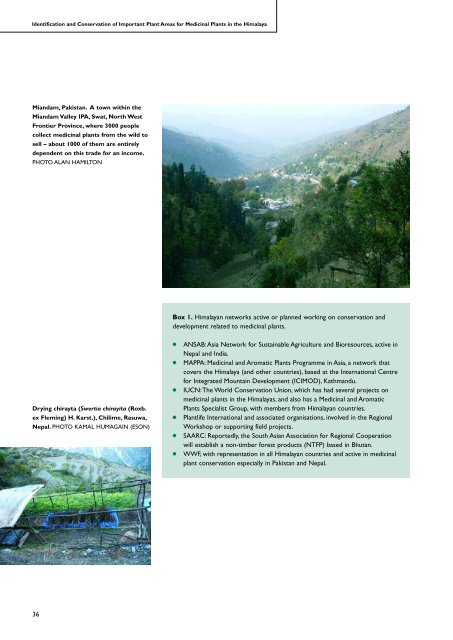Identification and Conservation of Important Plant Areas - Plantlife
Identification and Conservation of Important Plant Areas - Plantlife
Identification and Conservation of Important Plant Areas - Plantlife
- No tags were found...
Create successful ePaper yourself
Turn your PDF publications into a flip-book with our unique Google optimized e-Paper software.
<strong>Identification</strong> <strong>and</strong> <strong>Conservation</strong> <strong>of</strong> <strong>Important</strong> <strong>Plant</strong> <strong>Areas</strong> for Medicinal <strong>Plant</strong>s in the HimalayaMi<strong>and</strong>am, Pakistan. A town within theMi<strong>and</strong>am Valley IPA, Swat, North WestFrontier Province, where 3000 peoplecollect medicinal plants from the wild tosell – about 1000 <strong>of</strong> them are entirelydependent on this trade for an income.PHOTO ALAN HAMILTONBox 1. Himalayan networks active or planned working on conservation <strong>and</strong>development related to medicinal plants.Drying chirayta (Swertia chirayita (Roxb.ex Fleming) H. Karst.), Chilime, Rasuwa,Nepal. PHOTO KAMAL HUMAGAIN (ESON)●●●●●●ANSAB:Asia Network for Sustainable Agriculture <strong>and</strong> Bioresources, active inNepal <strong>and</strong> India.MAPPA: Medicinal <strong>and</strong> Aromatic <strong>Plant</strong>s Programme in Asia, a network thatcovers the Himalaya (<strong>and</strong> other countries), based at the International Centrefor Integrated Mountain Development (ICIMOD), Kathm<strong>and</strong>u.IUCN:The World <strong>Conservation</strong> Union, which has had several projects onmedicinal plants in the Himalayas, <strong>and</strong> also has a Medicinal <strong>and</strong> Aromatic<strong>Plant</strong>s Specialist Group, with members from Himalayan countries.<strong>Plant</strong>life International <strong>and</strong> associated organisations, involved in the RegionalWorkshop or supporting field projects.SAARC: Reportedly, the South Asian Association for Regional Cooperationwill establish a non-timber forest products (NTFP) based in Bhutan.WWF, with representation in all Himalayan countries <strong>and</strong> active in medicinalplant conservation especially in Pakistan <strong>and</strong> Nepal.36
















